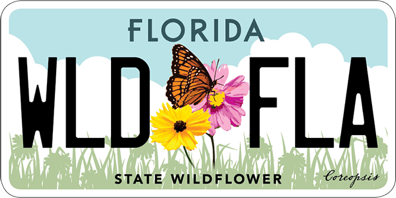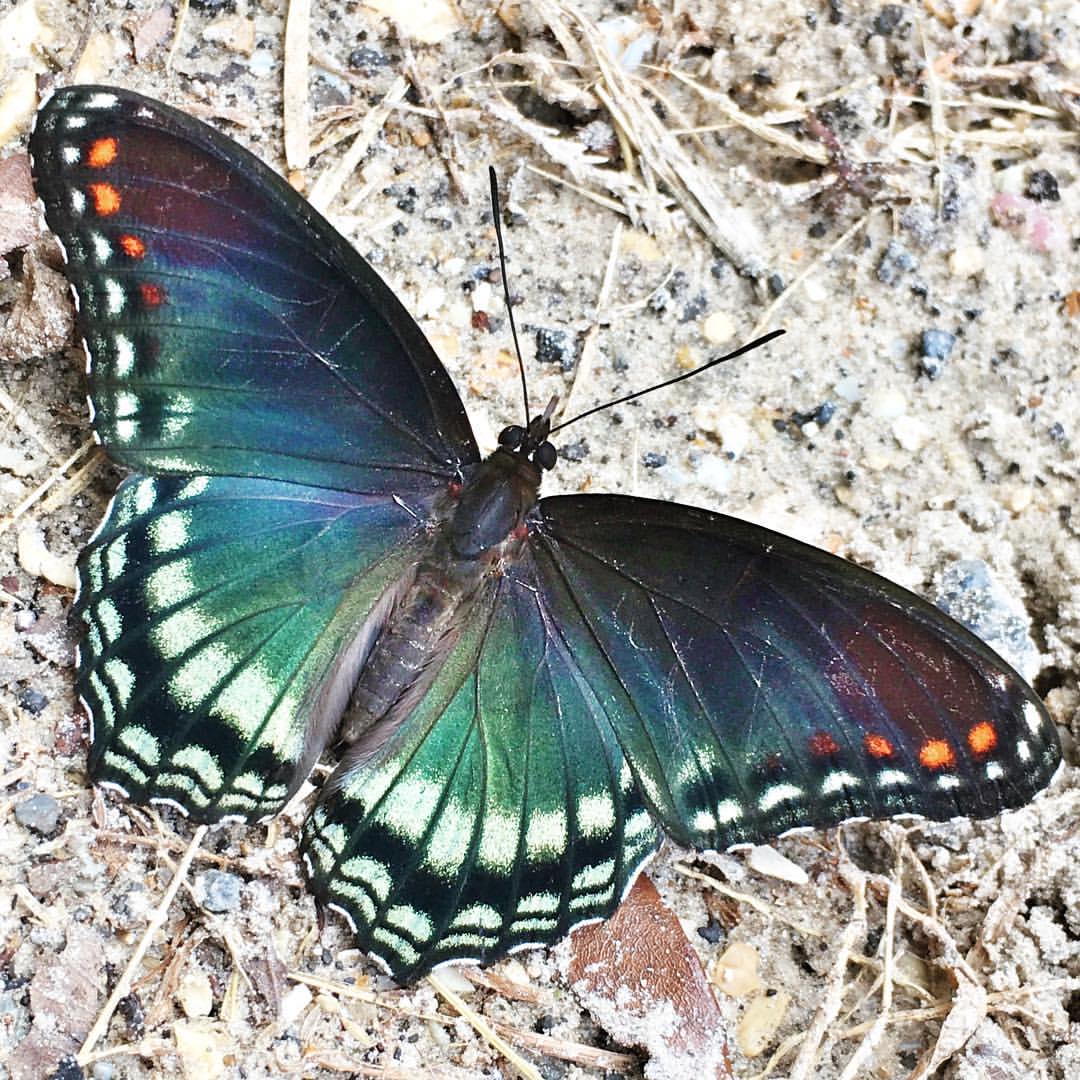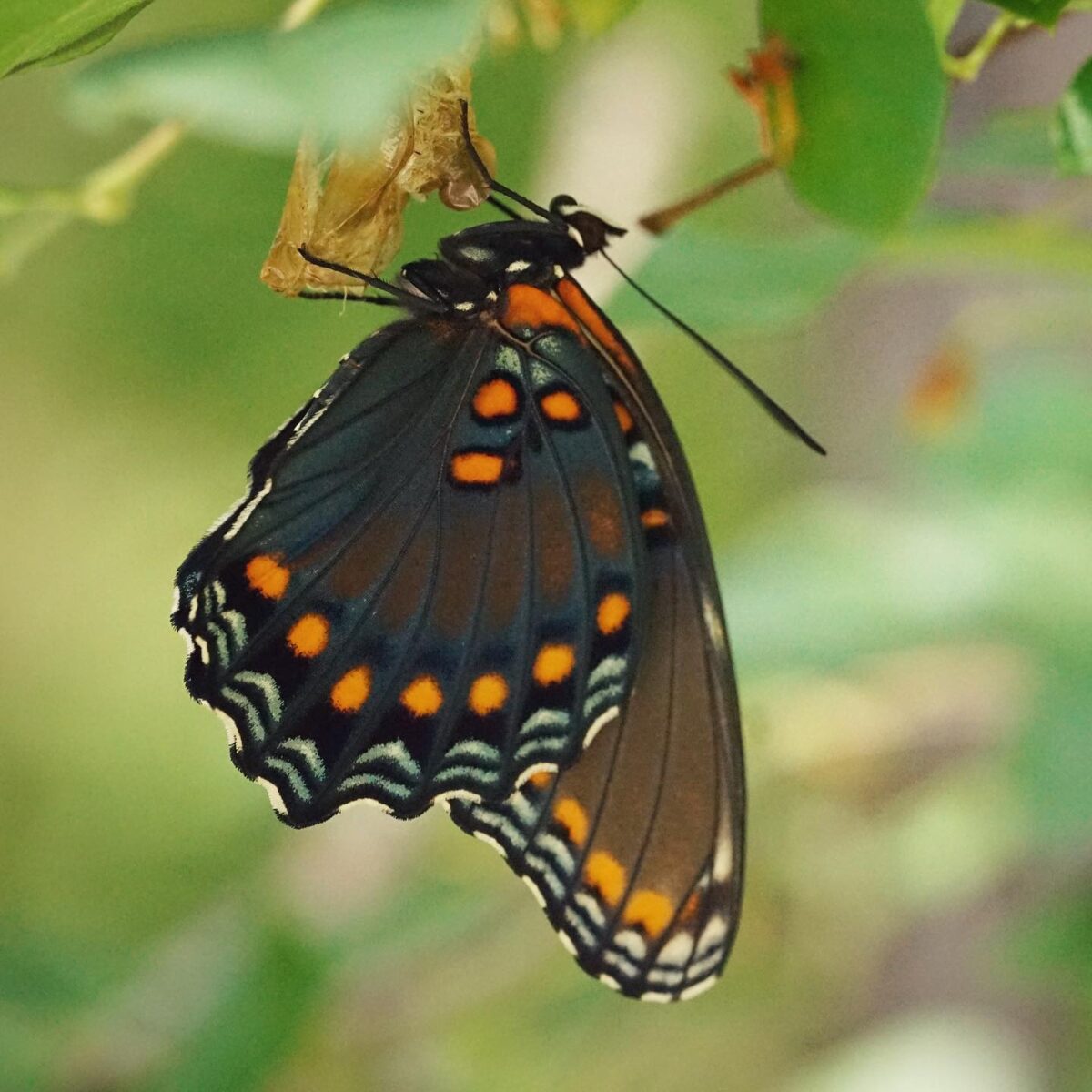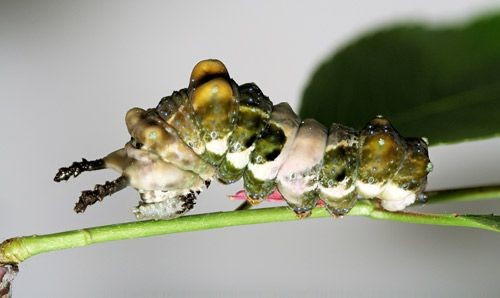Red-spotted purple
by Elora Pfriender
“Know your native pollinators” is a series of articles that will help you identify and appreciate Florida’s varied pollinators, including bees, wasps, butterflies, moths, beetles, flies, birds and bats. Pictured above: Red-spotted purple (Limenitis arthemis astyanax) by Emily Bell.
Contrary to its name, this widespread fruit-loving swallowtail mimic is neither red nor purple, but a vibrant shade of blue.
CLASSIFICATION
Class: Insecta
Order: Lepidoptera
Family: Nymphalidae
Genus species: Limenitis arthemis
Subspecies: L. a. astyanax
FUN FACT
Unlike many butterflies, the Red-spotted purple prefers fruit and tree sap to flowers.
IDENTIFICATION
The Red-spotted purple has a wingspan of 2.5 to 4 inches, with females typically slightly larger than males, though the sexes are otherwise not visibly different. With wings open, the dorsal side of the forewing appears black with faint brown tones and orange spots on the outer edges. The color transitions from black to blue, culminating in an iridescent blue on the hindwing. The ventral side is more brown overall, with orange banding along the forewing and large orange spots on the hindwing.
Although the Red-spotted purple has evolved to mimic the poisonous Pipevine swallowtail in color, it is not a swallowtail and lacks the hindwing tails characteristic of that family. It may hybridize with the White admiral subspecies (not found in Florida) or the closely related Viceroy (common in Florida) in regions where their populations overlap, resulting in variations in color and pattern.
FORAGING PREFERENCES
Unlike many butterflies, the Red-spotted purple prefers fruit and tree sap to flowers. Its preferred larval host plants include Black cherry (Prunus serotina) and Deerberry (Vaccinium stamineum), both native to northern and Central Florida. Adults may also feed on the rotting fruit and sap from these trees, as well as on animal droppings and carrion. They are also said to occasionally nectar on the small white flowers of woody plants.
HABITAT
The Red-spotted purple is common throughout Florida and the southeastern United States, ranging as far west as Texas and as far north as New Hampshire. Given their host and foraging preferences, they are often seen flitting just above the ground in wooded areas or resting high in the trees. They also frequently drink from puddles and can be found feeding on mud. Red-spotted purples are most often spotted in late summer.
DID YOU KNOW?
The Red-spotted purple belongs to the same species as the White admiral (L. a. arthemis), the nominal subspecies found in the northern United States and Canada. However, you’d likely never mistake one for the other — or even guess they’re the same species. In the southern United States, the Red-spotted purple evolved to mimic the poisonous Pipevine swallowtail (Battus philenor), which shares a similar range, as a strategy to ward off predators. Meanwhile, the White admiral retained its striking white-banded black wings, as this northern population is not mimetic.
LIFE CYCLE
Females lay spiked, round eggs that are patterned with small hexagons; they are laid singly on the tips of tree leaves. To avoid predation, the larvae mimic bird droppings, with bumpy greenish-brown bodies and streaky white markings. Like Viceroy larvae, they have brown horns and spines, although they are less spiny overall.
After eating a leaf, Red-spotted purple larvae use the remaining midrib — the leaf’s central vein — to construct perches called frass spars. These structures consist of the midrib, frass pellets (the larva’s dung), chewed-up leaf bits, and silk to hold everything together. Larvae rest on these spars when not feeding, which makes them appear unappetizing and distracts predators with dangling bits of waste and leaf matter.
In the winter, the larvae get to work again, building overwintering structures called hibernacula out of leaves and silk, where they remain until spring pupation. The pupae are white and brown, continuing the bird dropping disguise.
References:
- Butler, Jerry F. and Donald W. Hall. “Red-Spotted Purple Limenitis (=Basilarchia) arthemis astyanax (Fabricius) (Insecta: Lepidoptera: Nymphalidae: Limenitidinae).” UF Department of Entomology & Nematology, April 2022
- Cassie, Brian. “Red Spotted Purple / White Admiral.” Mass Audubon Butterfly Atlas Species Accounts
- Gilman et al. “Prunus serotina: Black Cherry.” UF/IFAS Extension, April 2019
- “Red-spotted Purple.” Alabama Butterfly Atlas
- “Red-spotted Purple.” iNaturalist
- “Vaccinium stamineum.” Florida Native Plant Society



